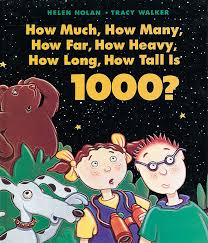Doing the Numbers: Some Books About Math
| Author | John Cech |
| Air Date | 4/26/2001 |

Doing the Numbers: Some Books About Math Transcript
It’s Mathematics Education Month, and numbers are in the air. For those younger children, who are just beginning to wrap their minds around the concept of larger number groups and the differences between numbers on paper and numbers in reality, you might want to bring home How Much, How Many, How Far, How Heavy, How Long, How Tall is 1000? by Helen Nolan from Kids Can Press. It sets up a string of basic comparisons that reaches kids where they live, and eat — like “How heavy are 1000 cookies? Could you lift them?” It depends, of course, upon the kind of cookie. Tracy Walker’s lively illustrations provide just the right tones of surprise and humor to carry this early exploration of the theory of relativity into infinity.
Ancient Computing, From Counting to Calendars by Machael Woods and Mary B. Woods from Runestone Press offers a more straight-forward, linear approach to its subject — the history of calculations until the fall of the Roman Empire — beginning with prehistoric tally sticks and “talking cords,” (pieces of rope or other string-like materials that were knotted to indicate amounts), and including other forms of measurement, like the cubit, that were based on parts of the human body. What comes through in their fascinating discussion of the emergence of counting technologies is the sheer brilliance and accuracy of some of the earliest methods and inventions, like the abacus, which was being widely used in China over 2500 years ago. It’s an eye-opening first study of this material and presents some important historical perspective for the young calculator.
But the classic book about math for elementary school kids, whether they’re whizzes or not, is Math Curse, John Scieszka’s and Lane Smith’s exploration of the spirals of panic that many children fall into when they encounter what can be, at first, a confusing world of numbers. The little girl at the center of the book has a math teacher who tells them that everything in their lives can be seen as a math problem, and this is where the troubles begin for our heroine: “I take the milk out for my cereal and wonder: 1. How many quarts in a gallon? 2. How many pints in a quart? 3. How many inches in a foot? 4. How many feet in a yard? 5. How many yards in a neighborhood? How many inches in a pint? How many feet in my shoes?” And it runs like that through the rest of the day — fractions at lunch, multiplication at birthday cup-cake time, and a maze of word problems at dinner. I won’t spoil the solution for you, except to say that it is true to the “Aha!” experience we’re all familiar with, when we finally, clearly learned how to do the math.